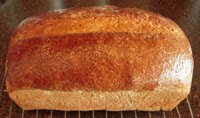 So here is my shot at the Oat Bran Broom Bread. I, for what it is worth, could have gone for a less descriptive name. The recipe is very much like the others that have gone before—make a soaker, make a biga, mix these with a few other ingredients the next day, and then jump to another page to see how to finish the bread.
So here is my shot at the Oat Bran Broom Bread. I, for what it is worth, could have gone for a less descriptive name. The recipe is very much like the others that have gone before—make a soaker, make a biga, mix these with a few other ingredients the next day, and then jump to another page to see how to finish the bread.The recipe produces a very pleasant if nondescript loaf. Reinhart suggest making it either in a loaf pan or as a free-standing loaf. There seems to be some inconsistencies with the French terminology. Reinhart calls for making a bâtard, by which he means a torpedo shaped loaf. This seems to be pretty standard usages in the US but I gather the French use boulot for a torpedo shape while a bâtard is more a log shaped loaf. (Any clarification or corrections would be appreciated.) In any event, I opted to make a log-shaped loaf.
The crust is, well, nondescript. It didn't brown very deeply, and the slashes seemed to disappeared into the crumb. This is a loaf that calls out to be brushed with butter or decorated with seeds. In the photo in the book, it appears that Reinhart covered the top of the loaf with bran. With his merging of recipes, this is a detail that seems to have been omitted from the recipe.
Overall, this is a pleasant loaf that I would repeat.





